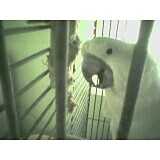|
Umbrella Cockatoo Conservation status: Vulnerable |
||||||||||||||||||
|---|---|---|---|---|---|---|---|---|---|---|---|---|---|---|---|---|---|---|
 |
||||||||||||||||||
| Scientific classification | ||||||||||||||||||
|
||||||||||||||||||
| Cacatua alba Muller, 1776 |
The Umbrella Cockatoo, Cacatua alba also known as White Cockatoo is a medium-sized cockatoo endemic to the islands of Halmahera, Bacan, Ternate, Tidore, Kasiruta and Mandiole in North Maluku, Indonesia. At first sight it appears to be a white parrot with brown or black eyes and a dark grey beak. If it is surprised, it extends a large and striking crest, which has a semicircular shape (similar to an umbrella, hence the name). The crest is normally recumbent. The underside of the wings and tail have pale yellow or lemon colour, which flash when they fly.
The Umbrella Cockatoo can live up to, and perhaps beyond, 80 years in age. They are very social, needing a lot of interaction. They can be very loud and their calls (a very loud screeching noise) can be heard up to three miles away.
The Umbrella Cockatoo weighs about 600gm (based on weights of two male pet birds aged about 1 and 3 years).
Contents |
Feathers
The feathers of the Umbrella Cockatoo are mostly white. However, both upper and lower surfaces of the inner half of the trailing edge of the large wing feathers are a yellow colour. The yellow colour is most notable on the underside of the wings because the yellow portion of the upper surface of the feather is covered by the white of the feather immediately medial (nearer to the body) and above. Similarly, areas of larger tail feathers that are covered by other tail feathers, and the innermost covered areas of the larger crest feathers are yellow. Short white feathers grow from and closely cover the upper legs.


Under side of left wing feathers
|
Umbrella Cockatoo as a vulnerable species
Although the Umbrella Cockatoo is not classified as an endangered species it is classified as vulnerable. It numbers in the wild have declined owing to habitat loss and illegal trapping for the cage-bird trade. It is listed in appendix II of the CITES list of protected species. This gives it protection by making the trade of wild caught birds illegal.
Umbrella Cockatoo as pet birds

Hand reared Umbrella Cockatoos can make good pets, as they are sociable, intelligent and they can learn tricks and be trained. They require a large cage (at least 3ft x 3ft x 5ft) and they need to exercise outside of their cage often. They can imitate basic human speech, but they are not considered the most able speakers among parrots. They are not an easy pet to keep and require a lot of time, devotion and understanding from their caregivers. They can destroy furniture with their powerful beaks and even the sweetest cockatoo may inflict a serious bite without provocation. Additionally, they can make a lot of loud noise and their large droppings are quite messy. Umbrella cockatoos as pets need so much care and attention, and can be so destructive and expensive to keep, that they are often passed from one owner to the next.
References
- BirdLife International (2004). Cacatua alba. 2006 IUCN Red List of Threatened Species. IUCN 2006. Retrieved on 11 May 2006. Database entry includes justification for why this species is vulnerable




 216.73.216.91
216.73.216.91 User Stats:
User Stats:
 Today: 0
Today: 0 Yesterday: 0
Yesterday: 0 This Month: 0
This Month: 0 This Year: 0
This Year: 0 Total Users: 117
Total Users: 117 New Members:
New Members:
 216.73.xxx.xx
216.73.xxx.xx
 Server Time:
Server Time: